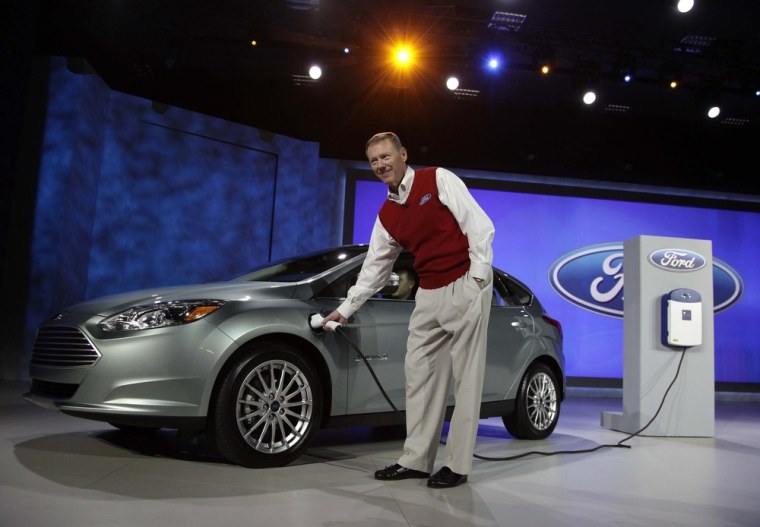The devastating earthquake that rocked Japan March 11 not only destroyed the land and lives of thousands but also shook up the established order in the global automotive industry.
Toyota — which had ranked No. 1 in global sales in recent years — continues to struggle to resume full production and is all but certain to slip behind long-time rival General Motors, at least for 2011.
But longer-term, the struggle for dominance in the car industry is likely to be more than just a two company shoot-out. Volkswagen has long made it known it’s in the hunt for the global sales crown. And now Ford may also be sniffing the chance to regain the lead it lost more than three-quarters of a century ago when it was still building the Model T.
Ford CEO Alan Mulally has outlined plans to boost the carmaker’s worldwide sales volumes by more than 50 percent by mid-decade, putting it close to parity with the industry’s two 800-pound gorillas, GM and Toyota.
But Ford won’t find its task an easy one. The carmaker faces a variety of challenges, including the need to revive its long-struggling Lincoln brand and rebuild its European operations, which have been lagging behind some key competitors, notably Volkswagen, for the past decade.
Mulally acknowledges that the new global goal will require the automaker to finally gain some real traction in Asia, a region the CEO expects to account for at least a third of Ford’s volume going forward. Nowhere is Ford’s challenge more apparent than in China, a market it has had little success cracking. While GM now holds a hefty 15 percent market share in China, Ford has been able to capture only 4 percent of what is now the world’s largest automotive market.
Mulally has had little patience with business-as-usual since joining Ford in late 2007. He has shaken up the company’s management structure and transformed its operations from a network of regional fiefdoms into a truly integrated global entity.
Key to that strategy, dubbed “One Ford,” is the consolidation of the Ford product portfolio. Rather than duplicate efforts from one market to another, Ford is focusing on products that can be built and sold around the world, such as the new 2012 Focus. By creating economies of scale, Ford can “can make up” for the lower margins made on vehicles like the Focus, which have traditionally been a drag on the company’s balance sheet, according to Ford’s Chief Financial Officer Lewis Booth.
Ford has counted on sales in North America to generate the lion’s share of its earnings to date, placing emphasis on big, profitable trucks like the full-size F-150 pickup. While those offerings won’t go away, company planners recognize that even the U.S. is on a downsizing path. Worldwide, Mulally’s new growth plan predicts that small cars and crossovers will account for 55 percent of Ford’s sales volume by 2020, up from 48 percent at present.
Standing out in a crowded field won’t be easy for Ford. The carmaker is taking a multi-pronged approach, among other things promising to “democratize technology,” according to global marketing czar Jim Farley. For example, when Ford reintroduced a new Taurus in 2010, the car featured a “cross-traffic alert system,” designed to detect oncoming vehicles when the car was backed out of a parking spot. The technology had only just debuted on the significantly more expensive BMW 7-Series.
Ford is also putting a premium on fuel efficiency. In fact, global product development chief Derrick Kuzak has proclaimed a goal of “being the best, or at least being among the very best, in terms of fuel economy, in every segment where we compete.”
That goal may gain some traction at a time when fuel prices are again nudging record levels, but Ford isn’t the only carmaker emphasizing mileage. With the launch of its updated Accent, Hyundai now has four different car models delivering highway mileage in excess of 40 miles per gallon.
Meanwhile, Ford has continued to lag as an also-ran in the hybrid segment, well behind Toyota, despite the steady rollout of new models like the Lincoln MKZ, which was notably the first product on the market that allowed buyers to choose either a conventional gasoline engine or an optional gas-electric powertrain at no additional cost.
Ford hopes to break out of the battery ghetto over the next several years by launching five advanced electric vehicles, including a pure battery-electric version of the Focus, as well as both standard and plug-in hybrid versions of the upcoming C-Max microvan.
“This is our Prius fighter,” said Farley, announcing that the C-Max will become the first dedicated hybrid model in the Ford vehicle line-up. The carmaker is hoping the distinctive shape and attributes of the new “people mover” will yield the same sort of brand halo that Toyota has gotten with its dedicated hybrid.
With the addition of the C-Max Hybrid and plug-in C-Max Energi — as well as the Focus Electric and other new electrified offerings — Ford hopes to nearly triple sales of its battery-based vehicles to 100,000 a year by 2013.
But that’s just a drop in the bucket compared to the global sales increases Mulally has in mind.
Ford’s management team is betting that, like Toyota, its electric vehicle program will burnish the automaker’s corporate image, underscoring its commitment to both technology in general and fuel efficiency in particular.
Indeed, Ford will need to project a clear sense of leadership if it’s to crack the industry’s established order.
